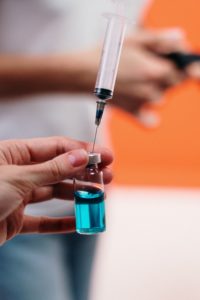Respiratory Syncytial Virus: Newly Resurgent
December 5, 2022
 Introduction
Introduction
We seem to be in a sort of Golden Age of respiratory viruses, including flu, SARS-CoV2 and respiratory syncytial virus (RSV). RSV is an enveloped negative strand RNA virus with a genome of approximately 15,000 nucleotides encoding 11 proteins. There are two serotypes, A and B, which can be discriminated by antibody reactivity. Two of the envelope proteins, G and F, mediate attachment to and fusion with target cells. As with other enveloped viruses, these proteins are the targets of neutralizing antibodies. Its transmission is airborne and it is highly contagious, but it generally only causes symptoms typical of common colds. However, it can cause more serious symptoms, including pneumonia and bronchiolitis, especially in infants, the aged, and the immunocompromised.
Why has RSV arrived in the news? For one thing, it is concurrent with infections with flu virus and (especially) SARS-CoV2 omicron. For another, there is now an unusually high incidence of RSV infections. This may be due to the isolation caused by Covid leading to decreased low level exposure to RSV and a resultant waning of immunity. This is not entirely clear; however, the low level of RSV infections during the peaks of the Covid pandemic is consistent with this idea. This combination of infections is putting a heavy burden on the health system, especially in the face of staffing shortages exacerbated by the persistent Covid pandemic. There is some hope that viral interference, in which an infection with one respiratory virus leads to an interferon-mediated resistance to superinfection with another virus, will help limit the possibility of simultaneous epidemics.
There are no highly effective antiviral drugs against RSV. Ribavirin, an RNA synthesis inhibitor, is sometimes used, but its efficacy is unclear, and it is expensive and toxic. Passive vaccination of at-risk children during high RSV season with palivizumab, a monoclonal antibody against the F protein, reduces hospitalization and death, but needs to be more widely available. There are no licensed RSV vaccines at present.
 Early development of an RSV vaccine led to serious problems. The first attempt, using formalin-inactivated virus to vaccinate infants against RSV, actually increased hospitalization among vaccinees to 80%, compared to 5% among unvaccinated controls, and several deaths resulted. This phenomenon, called antibody enhanced respiratory disease, injected a great deal of caution and delay in development of further RSV vaccines. Recent advances in understanding the three-dimensional structure of the F protein has allowed the design of stabilized forms of the pre-fusion protein. As an eventual result, there are currently four RSV vaccine candidates for adults awaiting FDA approval, with others in the pipeline.
Early development of an RSV vaccine led to serious problems. The first attempt, using formalin-inactivated virus to vaccinate infants against RSV, actually increased hospitalization among vaccinees to 80%, compared to 5% among unvaccinated controls, and several deaths resulted. This phenomenon, called antibody enhanced respiratory disease, injected a great deal of caution and delay in development of further RSV vaccines. Recent advances in understanding the three-dimensional structure of the F protein has allowed the design of stabilized forms of the pre-fusion protein. As an eventual result, there are currently four RSV vaccine candidates for adults awaiting FDA approval, with others in the pipeline.
The candidates include protein subunit vaccines, developed by Pfizer and GSK, an adeno-based vaccine by Janssen, and an mRNA vaccine by Moderna. Pfizer announced that their vaccine was 86% effective in preventing severe disease in patients over 60 years of age in a Phase 3 trial and was well tolerated. Similarly, GSK presented Phase 3 results showing that their vaccine was 83% effective in preventing lower respiratory tract disease and 94% against severe lower respiratory tract disease among people over 60 years old. Results from Janssen’s adenoviral vectored vaccine in a Phase 2b trial gave 70-80% protection in those 65 and older from lower respiratory tract disease. The Moderna vaccine, mRNA-1345, is currently undergoing Phase 3 trials. Some of these vaccines are also intended for pregnant mothers as a way of immunizing the infant through maternal antibodies. Vaccines for infants remain much more problematic, although passive vaccination with a long-lasting neutralizing monoclonal antibody, nirsevimab, showed an efficacy of 75% against lower tract respiratory disease in infants in Phase 3 trials.
Conclusion
It seems likely to be a difficult year for respiratory viral infections. However, there does seem to be hope (at least in the case of RSV) for considerable respite in the future in the form of effective vaccines and therapeutic neutralizing monoclonal antibodies.
References
- 1. Di Mattia, G., et al., During the COVID-19 pandemic where has respiratory syncytial virus gone? Pediatr Pulmonol, 2021. 56(10): p. 3106-3109.
- 2. Cohen, J., Will viral interference hold off the tripledemic? Science, 2022. 378(6622): p. 814-815.
- 3. McLellan, J.S., et al., Structure-based design of a fusion glycoprotein vaccine for respiratory syncytial virus. Science, 2013. 342(6158): p. 592-8.
- 4. Hammitt, L.L., et al., Nirsevimab for Prevention of RSV in Healthy Late-Preterm and Term Infants. N Engl J Med, 2022. 386(9): p. 837-846.
